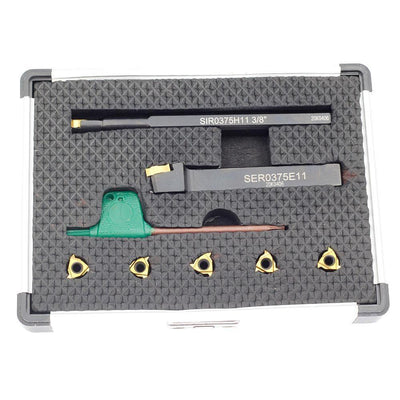When it comes to machining hardened steel, selecting the right carbide insert is critical to achieving both precision and durability. Hardened steel, typically defined as steel that has undergone heat treatment to achieve increased hardness, presents a significant challenge for cutting tools. The hardness of the material often leads to rapid tool wear, reduced cutting performance, and higher operational costs if the wrong inserts are used. To ensure a smooth, efficient machining process, it's essential to choose the best carbide inserts tailored to handle the demanding nature of hardened steel.
Carbide inserts are widely regarded as the go-to solution for machining hardened steel due to their superior hardness, wear resistance, and ability to withstand high cutting temperatures. Carbide, a material made from tungsten carbide particles combined with a metal binder, is exceptionally hard - far harder than most steels. This allows carbide inserts to retain their sharp cutting edges much longer than their high-speed steel counterparts, making them ideal for machining tough materials like hardened steel.
The best carbide inserts for machining hardened steel feature a combination of toughness and wear resistance. To understand why, it's important to consider the characteristics of the material. Hardened steel typically has a hardness of 45 HRC (Rockwell hardness scale) or higher, and can reach up to 65 HRC in some cases. Cutting through such a material requires an insert that not only resists wear but can also handle the high forces and temperatures generated during the cutting process. Too soft an insert will wear quickly, while too hard an insert may become brittle and break under pressure. Therefore, the right balance between toughness and hardness is crucial for effective and efficient machining.
One of the most important factors to consider when selecting carbide inserts for hardened steel is the insert's grade. Carbide inserts come in different grades, which are designed for specific cutting conditions. For machining hardened steel, inserts made from fine-grain carbide grades are typically the best choice. Fine-grain carbide inserts have a dense, uniform structure, providing high wear resistance and improved cutting edge strength. These grades allow for smoother cuts, reduced heat buildup, and longer tool life, which is particularly valuable when working with materials that generate significant friction during the machining process.
Additionally, the coating on carbide inserts can significantly enhance performance. Many of the best carbide inserts for hardened steel come with a variety of coatings designed to improve wear resistance, reduce friction, and enhance heat dissipation. Popular coatings include titanium nitride (TiN), titanium carbonitride (TiCN), and aluminum oxide (Al2O3). TiN, for instance, is often used for its ability to reduce friction and increase tool life, while TiCN provides a more wear-resistant surface that excels in high-speed applications. Coated inserts not only extend tool life but also improve surface finish quality and allow for faster cutting speeds without sacrificing performance.
The geometry of the carbide insert also plays a vital role in its ability to machine hardened steel effectively. Inserts with specific geometries, such as sharp cutting edges, positive rake angles, and specialized corner radii, are designed to optimize cutting efficiency, reduce cutting forces, and improve surface finish. For example, inserts with a positive rake angle reduce the cutting force required to machine the hardened material, making the process smoother and more efficient. Similarly, corner radii on inserts help distribute the cutting forces more evenly, reducing the likelihood of insert chipping or premature wear.
Choosing the right insert also depends on the specific machining operation being performed. For roughing operations, where material removal rates are high, tougher carbide inserts with a stronger focus on impact resistance are required. These inserts are designed to withstand the heavy forces involved in removing large volumes of material. On the other hand, for finishing operations, where high surface finish quality is paramount, inserts with a finer grain structure and a sharper edge are more appropriate. These inserts allow for smoother, more precise cuts and improved surface finishes.
In addition to material selection, insert geometry, and coating, other factors such as cutting speed, feed rate, and tool alignment must be optimized for the best results when machining hardened steel. Carbide inserts, while durable, still benefit from careful control of machining parameters to maximize performance. For example, while increasing cutting speeds can improve productivity, it can also lead to increased heat generation, which can prematurely wear down the insert. Therefore, it's important to find the optimal cutting parameters that balance speed with tool life.
Proper coolant application is also vital when machining hardened steel with carbide inserts. Coolants help reduce heat buildup, minimize friction, and flush away chips from the cutting zone, preventing them from interfering with the cutting process. Choosing the right coolant, such as a high-pressure through-tool coolant system, can further enhance the life of carbide inserts, ensuring they continue to perform optimally through extended machining cycles.
The best carbide inserts for hardened steel are those that combine a high-quality carbide grade, an appropriate coating, and an optimized geometry to meet the specific demands of the machining operation. By selecting the right carbide inserts, machinists can extend tool life, improve surface finishes, and reduce overall machining costs, all while ensuring high levels of productivity and precision. As technology continues to advance, so too will the options available for carbide inserts, offering even more solutions for machining hardened steel with greater efficiency and cost-effectiveness.

